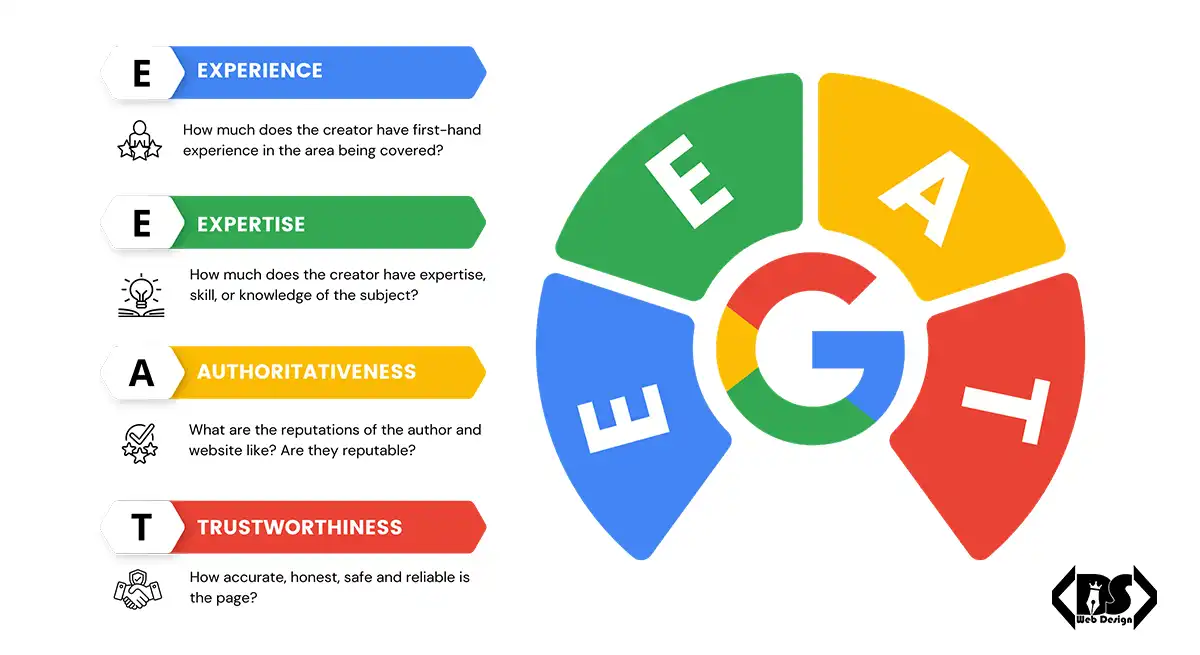
What is E-E-A-T
Google introduced an update to the familiar term E-A-T in December 2022, expanding it to encapsulate an additional factor: “experience.” This innovation introduced an acronym, E-E-A-T, affectionately termed “Double-E-A-T.” It is a cornerstone in Google’s evaluative mechanisms, the Search Quality Raters’ assessments.

What is EEAT

EEAT stands for Experience, Expertise, Authoritativeness, and Trustworthiness, and using EAT for SEO means creating credible content. Google first introduced EAT as part of its updated Search Quality Guidelines in 2014, then updated it later on to include the extra E, and will no doubt be updated for manual content reviewers to spot trustworthy sites since the introduction of AI chatbots.
Google is continually trying to improve the experience for its users, and to do so, they need to make sure ranking content aligns as closely as possible to search queries. False, low-quality, or unhelpful content harms Google and its users. Google uses EEAT to ensure the content that shows up is trustworthy and comes from the most credible standpoint. By prioritizing EEAT content, Google can ensure users get the best results.
Imagine if you searched for medical advice for treating migraines and the first page that came up was a dodgy, spammy website that gave questionable advice on home remedies that needed to be based on scientific evidence. While frustrating for the user, if Google did not implement EEAT in its guidelines, some users may see this information as truth and may potentially be harmful.
This is going to be a critical component of the new Search Generative Experience as Google wants to serve relevant and cited information in their generative AI responses, and working with an EEAT specialised agency will benefit businesses long term.
Let’s dive into each aspect of this E-E-A-T:
Experience (first ‘E’):
This term refers to the author’s firsthand experience with the topic they have produced content on. The creator’s credentials, qualifications, and demonstrated knowledge in a particular field are critical in establishing experience:
Relevant Education/Certification: Credentials related to the topic affirm experience.
Industry Work Experience: More industry time raises experience rating.
Published Quality Content: Prior high-quality work on the topic boosts the experience.
Positive Feedback: Commendations from field experts validate the experience.
Suppose a person professionally involved in health and fitness—perhaps as a dietitian or a personal trainer—is writing about weight loss. Given their specialized knowledge and hands-on experience, their insights will likely be far more informed and authentic than those from individuals outside this industry. This logic mirrors the evaluative criterion utilized by Google. In an instance where a medical expert writes a medical article, it’s not just an article—it’s a testament to the writer’s substantial familiarity and expertise in the subject. Google prioritizes such content as it promises high-quality information for the reader.
Expertise (second ‘E’):
This term relates to the knowledge and experience of the content creator. Content written by subject matter experts is usually considered more reliable and trustworthy, leading to better search rankings:
Content Quality: Clear, well-written content signifies expertise.
Comprehensiveness: All-encompassing content reflects mastery.
Accuracy: Current, correct content underpins expertise.
Referencing: Citing credible sources highlights expert acumen.
Authoritativeness (‘A’):
This term refers to the overall credibility of a website or a specific content creator. This can be measured through the number and quality of inbound links, mentions in reputable sources, and a strong reputation within a particular field or industry. An authoritative website is one that’s widely recognized as a leader or reliable resource in its niche:
Social Media Presence: Large social media following signals authority.
User Engagement: Content that provokes shares and comments denotes authority.
Peer Recognition: Compliments from experts elevate authority score.
Trustworthiness (‘T’):
This term represents how safe and reliable a website appears. Factors such as clear contact information, privacy policies, secure connections (HTTPS), and good user reviews can help enhance a website’s perceived trustworthiness:
Transparency: Revealing background and qualifications enhances trust.
Objectivity: Bias-free, factual content indicates trustworthy sources.
Independence: Content without sponsorships or promotions is deemed more trustworthy.
With the new addition of “Experience” in the E-E-A-T, Google is putting even more emphasis on user experience, acknowledging that a positive and seamless user experience is just as necessary as the expert and authoritative content. By considering all these elements, website owners can optimize their content and structure to align more closely with Google’s guidelines and improve their search engine rankings.
A Simple EEAT Checklist for Your Website

Now we understand EEAT as a concept and how we act it out, here’s a simple checklist to walk through on your website and add to if you’re missing them:
Physical Address: Proves business legitimacy.
Phone Number: Facilitates easy customer contact.
Domain Email Addresses: Indicates customer support responsiveness.
Meet the Team Page: Offers insight into your company, building credibility.
About Us Page: Communicates business identity, increasing trust.
Author Page: Displays your qualifications and expertise.
Author Bio: Briefly introduces you and your expertise to readers.
Author Brand SERP: Showcases all your written content, improving visibility.
Contact Us Page: Easy contact option boosts credibility.
Testimonials: Positive customer feedback builds trust.
Accreditations: Certifications from notable organizations confirm legitimacy.
Awards: Affirms leadership within your field.
Awards SERP: Highlights your awards, enhancing visibility.
Social Profiles: Active social engagement reveals audience involvement.
Privacy Policy: Details personal data collection, usage, and sharing.
Cookie Policy: Informs about your website’s cookie usage.
Terms and Conditions: Specifies website usage terms, protecting legally.
Case Studies: Real-world success examples establish trust.
Careers Page: Attracts quality talent, increasing credibility.
GDPR Compliance: EU data collection compliance signifies trust.
Modern Slavery Statement: Declares your stand against modern slavery.
Accessibility: An inclusive website promotes credibility.
Code of Ethics: Displays company values and principles.
Disclaimer: Limits liability for specific actions/events.
Editorial Policy: Describes content submission/publication rules.
Complaints Policy: Explains complaint handling, promoting credibility.
All Rights/Copyright: Protects intellectual property and affirms legitimacy.
Favicon: Enhances brand recognition and trust.
Company Number: Verifies business legitimacy.
SSL Certificate: Encrypts website data, bolstering security and trust.
What is YMYL?

YMYL stands for Your Money, Your Life. Google uses this classification for content that would affect your financial livelihood or overall well-being. Like our previous example about searching for medical information, false content can harm users.
Thinking of EAT and YMYL together is essential because Google focuses the most on EAT for YMYL articles or websites. If you own a website that discusses medical or financial advice, speaking from a place of authority and truth is essential.
The combination of EAT and YMYL is why educational institutions and credible organizations rank high. These types of sites have a high domain authority because it’s clear that they’re delivering expert information.
How Does Google Factor EEAT and YMYL?

You can think of YMYL as a category of websites that determines how essential EEAT needs to be. The more YMYL content a website includes, the more Google will scrutinize whether the content upholds EAT.
The bottom line is that Google wants to prioritize websites that serve a beneficial purpose. Google will rank sites shallow if their primary purpose is misleading or harmful to users.
Technically, EEAT SEO for Google factors into a manual content review process rather than one of Google’s algorithms. While Google doesn’t disclose its specific ranking process, the Search Quality Guidelines give us a solid idea of what’s prioritized.
Examples of EEAT and YMYL Content

YMYL content can apply to full sites or individual pieces of content. Some areas that Google would consider as YMYL are:
- WebMD
- The Mayo Clinic
- Business Insider
- Nerd Wallet
- wikiHow
These sites offer different types of advice, whether medical-based, financial, or more general. Even if you don’t own a place as big as these examples, your content may still include YMYL aspects.
Examples of EEAT content include anything written by subject matter experts or peer-reviewed studies. SME content is the most remarkable example of EAT, though you can still create EEAT content without hiring experts.
EEAT content doesn’t have to apply to YMYL, so you can create EEAT articles for various topics. If you’re a local business, one of the best ways to integrate EAT within your website is through reviews, testimonials, and case studies. User-generated pieces of content help signal to Google and other users that you’re a credible source.
How to Incorporate EEAT and YMYL

How you incorporate EEAT and YMYL into your website will depend on your products, services, and information. If you’re a service provider, you likely already have an expert point of view in your industry. Creating EEAT content is as easy as writing based on your expertise.
If you aren’t a firsthand expert on the topics you want to write about, consider hiring subject matter experts. Especially if you’re incorporating YMYL content, don’t limit your writing to keyword research. Your content should answer users’ questions truthfully and as helpful as possible.
Staying on Top of EEAT SEO, YMYL, and More

If you need to become more familiar with EEAT SEO, YMYL, and other Google ranking factors, we recommend staying on top of Google’s changes. Google is constantly adapting to user search behavior and updating its search engine. With every change, Google aims to become faster, more efficient, and more helpful.
As a business owner or marketer, your goal is to work in tandem with Google as much as possible. Google has its users at the top of mind – not your website. To stay competitive, keep your audience as your priority to develop reliable and helpful content.
By partnering with an SEO agency, you can benefit from expert SEO specialists without spending time researching. At DS Web Design, we’re constantly maintaining Google’s trends and changes to provide the best services for your website. Get in touch with us today to learn more.



